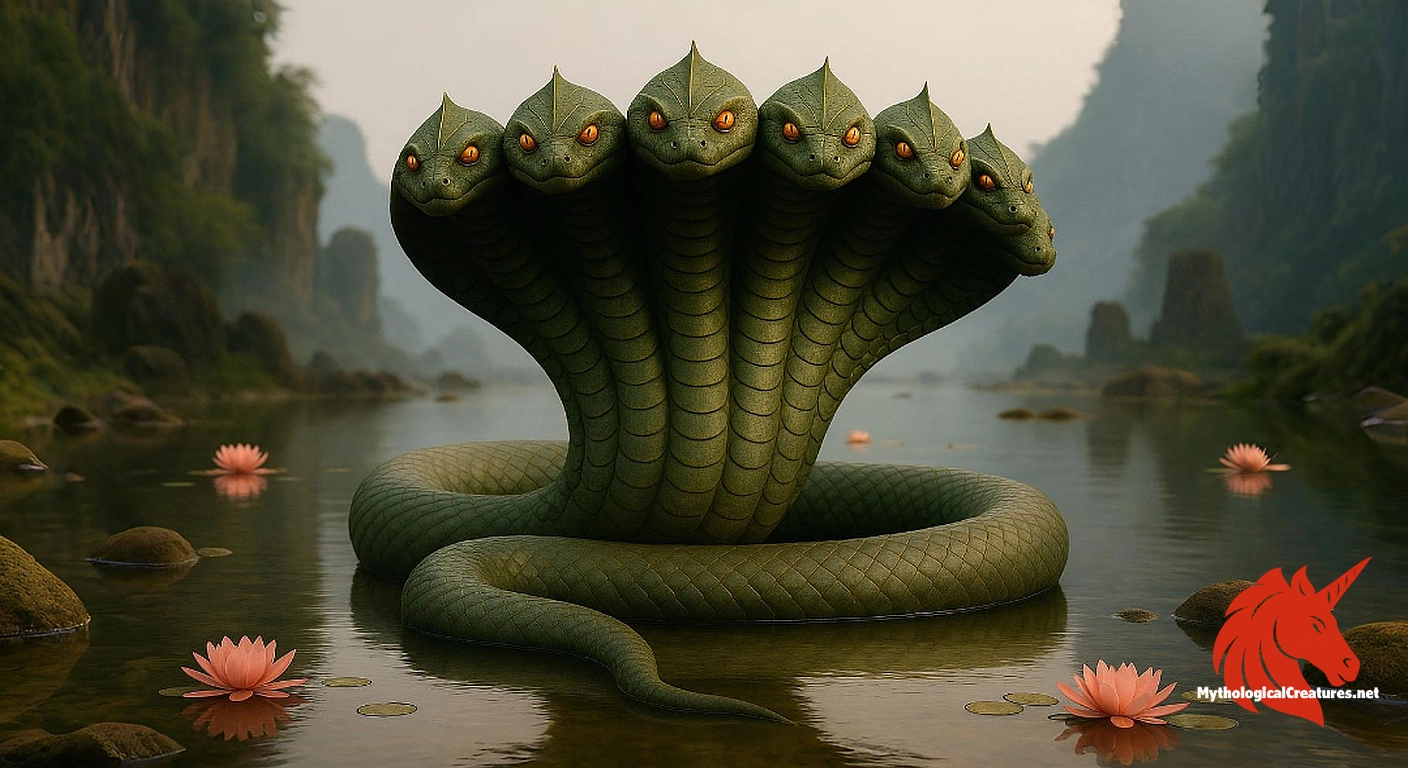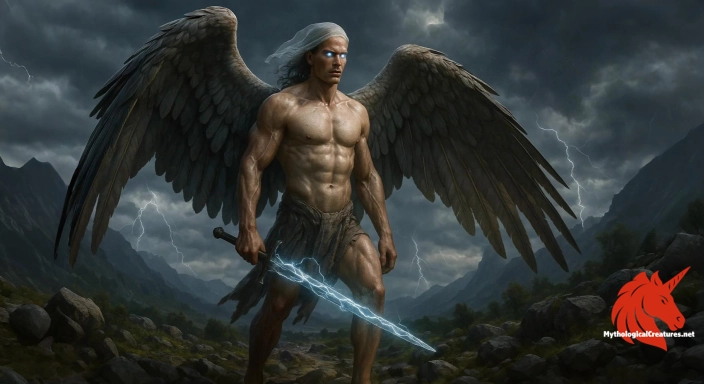Shesha: Shesha, also known as Adishesha or Ananta Shesha, is a divine serpentine demigod and king of the serpents in Hindu mythology.

Shesha
Shesha - Embodies the eternal, unchanging foundation of the cosmos and supports the divine order by holding the planets and sustaining Vishnu.
Origins & First Encounters
Shesha, revered as the eternal remainder and a primordial serpent deity, is a central figure in Hindu cosmology whose origins reach back to the ancient Sanskrit traditions. His name, meaning 'he who remains', symbolises the enduring nature of the cosmic order despite the cyclical process of creation and dissolution. He is depicted as the mighty nagaraja, whose hoods cradle the celestial bodies and uphold the universe, embodying stability in a constantly changing cosmos. Early texts and iconographic traditions solidify his role as the divine support for Vishnu, often illustrated as the sacred bed on which the deity reclines. His legends, found in both the Puranas and the Mahabharata, weave together themes of endurance, cosmic balance, and divine continuity. Shesha’s myth seamlessly integrates the physical and metaphysical realms, serving as a reminder of eternal resilience and the infinite cycle of time. The fusion of myth and ritual surrounding his persona has allowed him to transcend mere narrative, influencing devotional practices and art across generations. His story remains a source of inspiration, reflecting deep philosophical insights and the timeless quest for understanding the nature of existence. In this way, Shesha continues to enthral devotees and scholars alike with his sublime representation of permanence amidst ceaseless change.
Source Texts & Tale Variants
Ancient scriptures such as the Puranas offer rich portrayals of Shesha as both a divine serpent and a fundamental pillar of cosmic creation. These texts vividly describe him bearing the celestial orbs upon his expansive hoods while continuously singing the glories of Vishnu, casting him as a vital link between the heavens and the earth. The Mahabharata, particularly in the Adi Parva, further explores his origins, albeit with varying accounts that range from his creation by Vishnu to his descent from the union of Kashyapa and Kadru. The diversity in these narratives highlights the dynamic process of myth-making, where the shape of his legend shifts with cultural context and textual tradition. In many inscriptions and devotional literature, his image appears repeatedly, reinforcing his role as an eternal support of universal order. Story variants even extend into the realm of incarnations, where figures such as Lakshmana and Balarama are sometimes associated with his divine lineage. This multiplicity of versions has enriched his myth, lending layers of interpretative depth. The interplay of these sources underlines how deeply interwoven his narrative is with the broader tapestry of Hindu cosmology. Each textual strand, while distinct, contributes to the enduring legacy of Shesha as a symbol of endless preservation.
Form & Powers
Iconographic depictions of Shesha present him as an immense and majestic multi-headed serpent, whose sinuous, infinite form is imbued with both formidable strength and serene grace. His colossal body is often illustrated as enveloped in intricately detailed, shimmering scales that seem to capture the glints of starlight, evoking a sense of the boundless cosmos. Every hood he bears is rendered with elaborate care, arching broadly to cradle entire worlds, and symbolising the all-encompassing nature of existence. The depictions accentuate his numerous mouths, from which emanates a celestial melody that continuously extols the divine virtues of Vishnu. His physical presence is designed to convey not only power but also a gentle, meditative calm that reflects the eternal rhythm of creation and dissolution. Artisans have often portrayed him with eyes that carry a deep, enigmatic wisdom, inviting onlookers to contemplate the mysteries of time and space. His form, both awe-inspiring and benevolent, underscores an important duality: the fierce energy required for creation and the tranquil permanence that follows. The overwhelming magnitude of Shesha’s presence in art and sculpture serves as a potent symbol of infinity and the resilient nature of the universe, bridging the temporal with the eternal.
Regional Faces
The representation of Shesha varies significantly across different regions, reflecting unique local artistic sensibilities and theological interpretations. In the Indian heartland, he is consistently depicted as the divine seat of Vishnu, a motif that underscores his pivotal role in maintaining cosmic equilibrium. South Indian temple art, in particular, celebrates his form with intricately carved stone sculptures and vivid frescoes that capture both the grandeur and mysticism of his legend. In rural traditions, folk narratives embellish his myth with additional layers of local symbolism, often linking him to themes of fertility and the natural cycles of life. Regional festivals sometimes celebrate his legacy through elaborate processions and ritual re-enactments, which further solidify his relevance in communal spirituality. Outside the subcontinent, in Southeast Asian countries such as Cambodia and Indonesia, adaptations of his myth integrate indigenous motifs, transforming him into a figure that harmonises Hindu iconography with local cultural narratives. These variations are not confined to visual art but are also expressed through dance, theatre, and ritual practices that echo the ancient motifs of renewal and protection. Ultimately, regardless of the subtle regional differences, Shesha’s image remains a unifying symbol of cosmic maintenance and timeless endurance across various cultural landscapes.
Cultural Parallels
In the global panorama of mythological beings, Shesha emerges as a unique yet resonant figure whose serpentine symbolism finds parallels in many cultures. His depiction as an eternal, world-supporting serpent is reminiscent of the Norse Jörmungandr, whose immense form encircles the earth, albeit with contrasting roles and narrative contexts. The cyclical nature of his existence, perpetually present as the world is renewed, bears similarities to the Ouroboros of Western symbolism, a creature that also encapsulates ideas of eternal return and cyclical time. Moreover, the way Shesha bridges the realms of the divine and the human evokes echoes of the Chinese dragon, revered not only for its power but also for its role in harmonising the natural and supernatural. These cross-cultural comparisons highlight a shared human fascination with serpentine beings, whose forms traditionally represent a deep-seated connection to the mysteries of existence and the infinite. While the specific attributes and mythic functions differ from one tradition to another, the enduring theme of renewal and stability is a common thread that unites these diverse symbols. Such analyses enrich the understanding of Shesha’s role, revealing how ancient themes continue to convey profound truths about life's cyclical nature. His multifaceted symbolism, therefore, stands not in isolation but as part of a broader tapestry of myth that spans continents and epochs.
Legacy & Modern Evolution
The myth of Shesha has evolved remarkably over the centuries, mirroring the dynamic interplay between ancient tradition and modern reinterpretation. Rooted in foundational Hindu cosmological texts, his legend has transcended simple narrative to become a symbol of eternal resilience and cosmic continuity. Historically, his portrayal as the colossal serpent sustaining the universe has inspired countless works of art, from stone carvings in medieval temples to delicate paintings and intricate sculptures. Over time, artists and scholars alike have reimagined his form and function to resonate with contemporary cultural and spiritual discourses. His image has been seamlessly integrated into modern literature, dance, and even digital media, reinforcing his status as a timeless emblem of stability amid change. Contemporary spiritual interpretations often view him as a metaphor for the enduring aspects of nature, emphasising themes of renewal, environmental stewardship, and the balance between tradition and progress. This ongoing evolution has allowed his myth to remain relevant, imbued with both historical gravitas and modern dynamism. The persistent reappearance of Shesha in diverse artistic and cultural expressions today echoes his ancient role as the custodian of cosmic order and the eternal force that endures, regardless of the vicissitudes of time.
Interesting Fact
Despite the inevitable cycles of creation and dissolution in Hindu cosmology, Shesha remains ever-present, symbolising the enduring foundation of the universe.
Quick Creature Info
Associations:
Our Mythic Legendary Rating:

Also Sometimes Known As:
Habitat:
Supernatural Powers:
Physical Attributes:
Abilities:
Behavior:
Lore:
Related Creatures, Tales or Lore
References
Discover Another Mythical Legend You May Not Have Heard Of?
Uncover the mysteries of ancient folklore and expand your knowledge of legendary beings from cultures around the world.
Dare to Meet the Drangue....
Mythical Disclaimer: The images and data on this site are derived from various historical and literary sources, but we have found that many myths often have multiple versions and interpretations across references, sometimes contradictory. As a result, these creature depictions are artistic interpretations—imaginative blends of folklore, legend, and a dash of AI guesswork. Because creature descriptions vary widely, our illustrations and accompanying information represent our best effort to honor mythology while bridging creative gaps. Enjoy these interpretations—just remember, we've done our best to respect the stories and validate available data, but in the realm of mythology, details often shift, imagination leads the way, and nothing is ever set in stone!
Curated by the Mythological Creatures Team (rev. May 2025)
